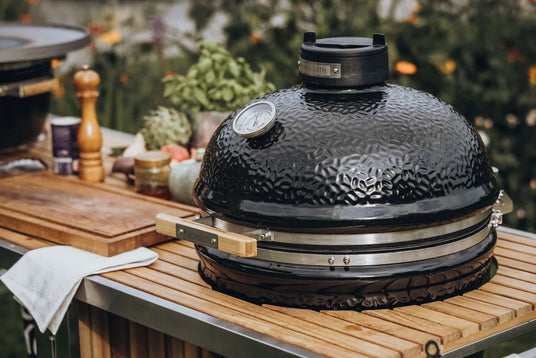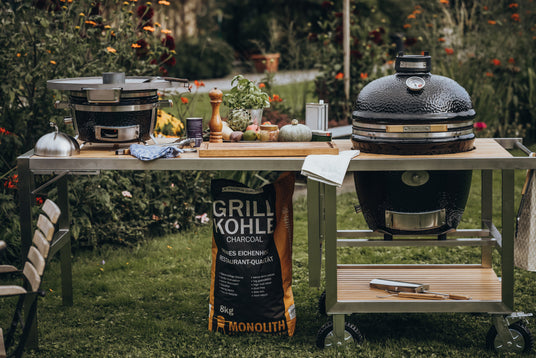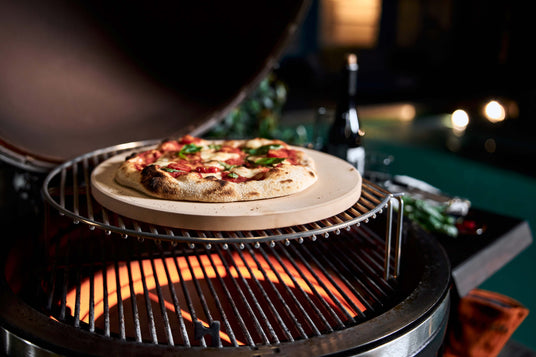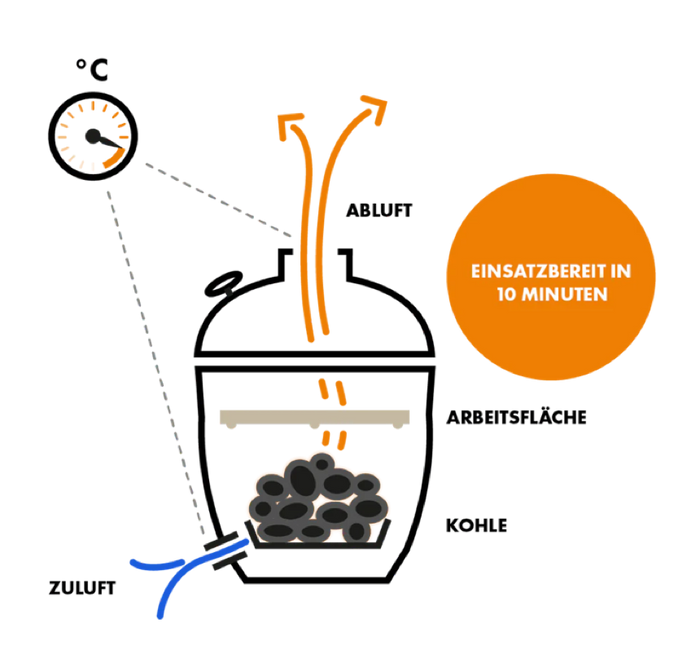
Loin of venison with pumpkin wedges, fan potatoes and wild mushrooms
The article Loin of venison with pumpkin wedges, fan potatoes and wild mushrooms appeared first on Petromax - Dutch Oven.
MONOLITH GRILL |
Humans have known about the heat-retaining properties of ceramics for at least 3000 years. After American soldiers in the middle of the 20th century took so-called "mushikamado", mobile ceramic cooking stoves made by Japanese field workers, back to America and developed the first charcoal barbecues from them, the concept of ceramic barbecues spread around the world. Today, a kamado grill is more than just a grill; it is a versatile cooking tool with unique features.
Thermal insulation, versatility, durability
The ceramic structure of a kamado grill provides unsurpassed heat insulation, allowing temperatures to be maintained precisely over long periods of time. This efficiency makes the Kamado grill a master of versatility - from searing and slow cooking to baking and smoking. Added to this is the impressive longevity that goes hand in hand with the robust construction.
When choosing the right Kamado barbecue, you should consider how much space you need, what equipment you prefer and how much you are prepared to spend. It's best not to compromise on material quality. MONOLITH offers a range of models that differ in size and features to meet the different needs of barbecue fans.
A kamado grill works by circulating hot air in its closed, ceramic chamber. Charcoal is ignited at the bottom of the grill and the air supply is regulated by valves at the bottom and top of the grill.
The heat is absorbed by the ceramic walls and distributed evenly throughout the grill, resulting in efficient and even cooking. Controlling the air supply and exhaust allows the user to precisely control the temperature.
The fundamental difference to an oven or gas grill is that the MONOLITH uses radiant heat from the ceramic instead of circulating hot air, which keeps the food much juicier.
The kamado is operated with charcoal and
heated by the chimney effect: air flows through the air inlet opening in
the combustion chamber and supplies the embers with oxygen.
The exhaust air flows out again at the top via the
exhaust air valve. The
temperature can be set to the exact degree via the supply and exhaust air openings. A temperature range of
90 - 400 °C can be used.
The fundamental difference to an oven or gas grill is that the MONOLITH uses radiant heat from the ceramic instead of circulating hot air, which
keeps the food much juicier. Thanks to the heat-storing ceramic
, only a small amount of energy is required to keep the MONOLITH at the selected
temperature.
This means that we can work in the
low temperature range for 24 hours with just 2 kg of charcoal
. All conceivable cooking methods can be used in the MONOLITH:
Direct grilling, indirect grilling, smoking, braising, drying, boiling,
roasting.
With MONOLITH, the Japanese heritage of the mushikamado meets advanced workmanship and timeless design. MONOLITH combines tradition with innovation.
The MONOLITH family consists of four model sizes: MONOLITH Icon, MONOLITH Junior, MONOLITH Classic and MONOLITH LeChef - choose your size, optimally adapted to your needs. The various features and the different series, Series 2.0 and Avantgarde, offer you exactly the barbecue luxury you need for your culinary experiences.
Some basic techniques and recipe ideas
A kamado grill opens up a world of culinary possibilities. Whether you prefer spicy grilling, slow cooking or baking a pizza, the unique temperature control makes it all possible in one appliance. Experiment with different techniques and discover new recipe ideas to enrich your grilling experience.
Here you can find Kamado recipes sorted by: Side dish | Fish & Seafood | Cakes & pastries | Vegetarian and more.
Caring for your Kamado barbecue is crucial to ensure its longevity. Regular cleaning of the ceramic parts and the grate as well as checking the seals and valves will ensure that your barbecue is always in top condition.
You can find all the instructions you need to care for your MONOLITH summarized here.
Kamado barbecues offer unparalleled versatility and efficiency, making them an excellent choice for barbecue enthusiasts. MONOLITH stands for quality and innovation that make every barbecue evening a special experience. If you are looking for a barbecue that combines tradition and modernity, a kamado barbecue from MONOLITH is an excellent choice.
Ceramic is the main material for MONOLITH kamado barbecues because it offers excellent heat insulation and retention properties. The thick ceramic walls effectively retain the heat in the grill, resulting in an even temperature distribution and minimizing fuel consumption.
In addition, ceramic is resistant to the high temperatures reached when grilling and offers a longevity that metal grills often cannot match. The insulation also ensures that the outside of the grill gets less hot, which increases safety when grilling.
The MONOLITH Kamado is characterized by its versatility, efficiency and durability. It can be used for a variety of cooking methods, including grilling, smoking, baking and even steaming, making it a complete outdoor kitchen.
Its unique ceramic design allows for precise temperature control that can be adjusted for different cooking requirements. In addition to its functional superiority, the MONOLITH Kamado's stylish and robust design adds aesthetic value to any outdoor area.
The temperature of a kamado barbecue is regulated by adjusting the air supply and the flue. Increasing the air supply increases the heat, while reducing the air supply lowers the temperature. To increase the temperature, open the lower valve (air supply) and the upper valve (flue) wider.
To lower the temperature, narrow these valves to reduce the air circulation. Fine adjustment of these valves enables precise temperature control for different cooking methods.
A range of accessories are suitable for maintaining your Kamado barbecue. A cover protects the barbecue from the weather when it is not in use. An ash shovel and an ash vacuum cleaner make it easier to remove ash and residual charcoal.
Barbecue brushes are helpful for cleaning the grill after use. It is also recommended to use special care products for ceramics to maintain and protect the outside of the barbecue. In addition, a stone lifter can be useful to safely move hot stones or grates.
Lighting a kamado grill takes a little practice, but with the right steps it's a simple process. Here is a step-by-step guide:
Never use alcohol or gasoline to light the grill, as this is dangerous and can affect the quality of the food. Learning the optimum settings for air supply and exhaust may take some trial and error.
Each kamado grill may behave slightly differently, so experience is the best teacher.
Remember that a kamado grill has excellent heat retention, so it is important to increase the temperature slowly to avoid overheating.
Mono-Lighter is backordered and will ship as soon as it is back in stock.





